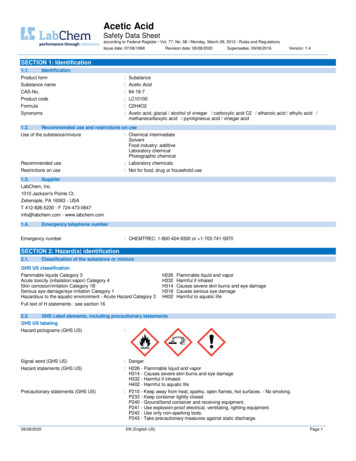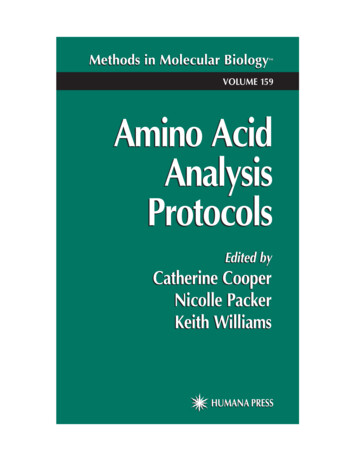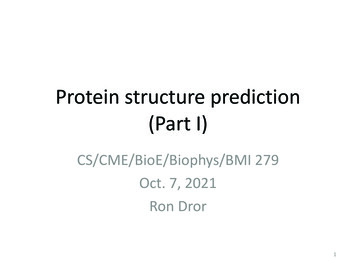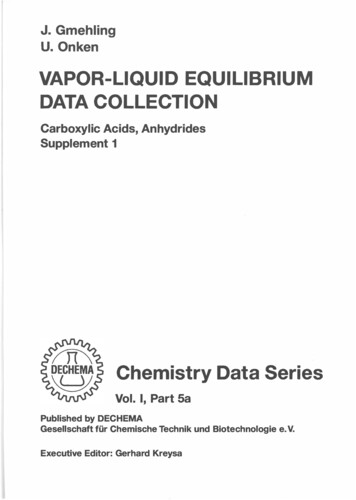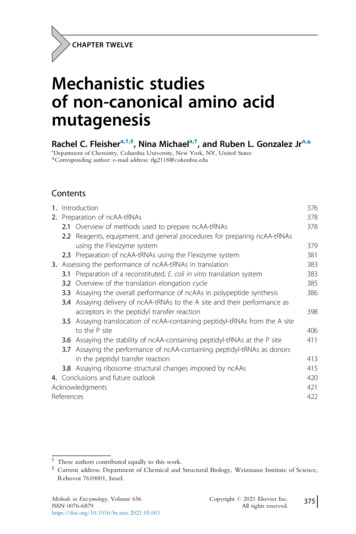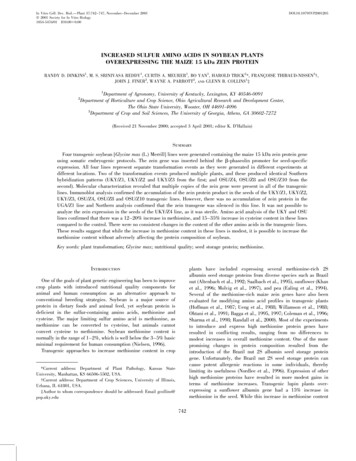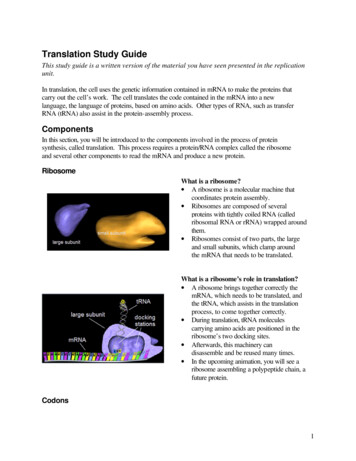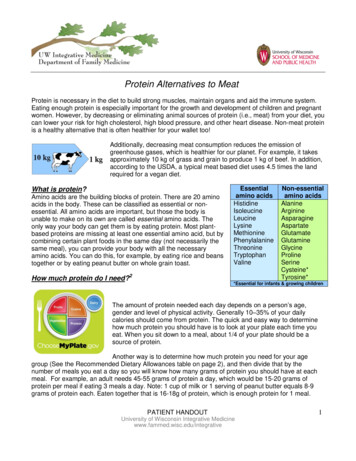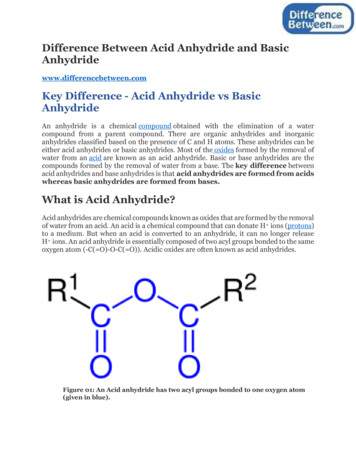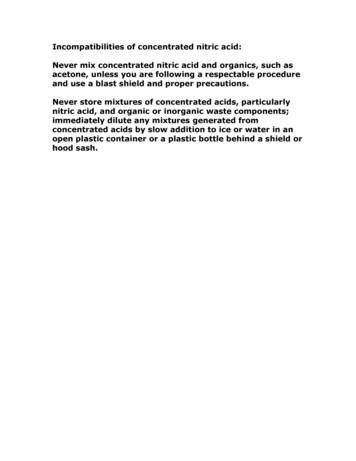
Transcription
AMINO ACID METABOLISMWarren JelinekI.THE HANDOUTThis handout is divided into several parts:1.a short synopsis of amino acid and nitrogen metabolism (SYNOPSIS OF AMINO ACID ANDNITROGEN METABOLISM);2.a short review of protein digestion in the gut and entry of amino acids into the blood and tissues(PROTEIN DIGESTION AND AMINO ACID ABSORPTION);3.a description of the mechanisms the body uses to mobilize nitrogen (AMINO ACID NITROGEN);4.a description of the mechanism the body uses to dispose of excess nitrogen (THE UREACYCLE);5.a description of the synthesis and degradation of selected amino acids, including examples ofphysiological states that influence the body's amino acid metabolism (SYNTHESIS ANDDEGRADATION OF AMINO ACIDS);6.a description of folate mediated single-carbon metabolism (TETRAHYDROFOLATE, FH4 , ANDTHE ONE-CARBON POOL);7.copies of slides shown in class that are not included in your textbook.II. STUDY QUESTIONS and this HANDOUT can be found at the course web site.
SYNOPSIS OF AMINO ACID AND NITROGEN METABOLISMA. Dietary proteins are the primary source of the nitrogen that is metabolized by the body. Average adult humans take in approximately 100 grams of dietary protein per day. Amino acids are produced by digestion of dietary proteins in the intestines, absorbed through theintestinal epithelial cells, and enter the blood.- Proteases that digest dietary protein are produced by the stomach (pepsin), pancreas (trypsin,chymotrypsin, elastase, carboxypeptidases), and the intestine (enteropepdidase,aminopeptidases). Various cells take up these amino acids, which enter the cellular amino acid pools. Amino acids are used for the synthesis of proteins and other nitrogen-containing compounds, orthey are oxidized for energy.B. The body maintains a relatively large free amino acid pool in the blood (approximately 35-65 mg / 100mL), even during fasting; tissues have continuous access to individual amino acids for the synthesis ofproteins and essential amino acid derivatives, such asneurotransmitters. The amino acid pool also provides theHemorrhageliver with substrates for gluconeogenesis and ketogenesis.ExerciseEmotionsThe free amino acid pool is derived from dietary amino acidsHypoglycemiaPainand the turnover of body proteins.Cold exposureInfectionsC. All nitrogen-containing compounds of the body aresynthesized from amino acids - cellular proteins,hormones (e.g., thyroxine, epinephrine, insulin),neurotransmitters, creatine phosphate, heme inhemoglobin and cytochromes, melanin, purine andpyrimidine bases.D. Proteins in the body are constantly synthesized anddegraded, partially draining and refilling the cellular aminoacid pools. In a well fed human adult, approximately 300 - 600 gramsof protein are degraded, and approximately 300 - 600grams of new protein are synthesized each day.- Protein turnover allows shifts in the quantities ofdifferent proteins produced as physiologyrequires, and removes modified or damaged proteins. In muscle, during fasting, or stress, thesynthesis/degradation equilibrium is shifted towardsdegradation, resulting in loss of muscle mass. Theresulting amino acids can be released into the blood forconversion to glucose by the liver to supply metabolicenergy for critical tissues (e.g., red blood cells and brain).- Insulin promotes protein synthesis by muscle, anddecreased blood insulin levels, during fasting forexample, result in net proteolysis and release of aminoacids from muscle into the blood.- Glucocorticoids (e.g., cortisol, a major stresshormone), released in response to fasting or stress,promote the degradation of proteins; carbon skeletonsof the resulting amino acids may be used as an ticotropicHormone(ACTH)ACTHCortisolAdrenal GlandCortisolCortisolPROTEIN DEGRADATION
E. As a source of energy, amino acid carbon skeletons are directly oxidized, or, in the starved state,converted to glucose and ketone bodies, and then oxidized. Nitrogen must be removed before the carbon skeletons of amino acids are oxidized. The liver is the major site of amino acid oxidation, but most tissues can oxidize the branched chainamino acids (i.e., leucine, isoleucine, valine). Most of the carbons from amino acid degradation are converted to pyruvate, intermediates of theTCA cycle or acetyl Co A. During fasting these carbons are converted to glucose in the liver andkidney, or to ketone bodies in the liver. In the well fed state, they may be used for lipogenesis.F. Amino acid nitrogen forms ammonia, which is toxic.G. The liver is the major site of amino acid metabolism in the body and the major site of urea synthesis.The liver is also the major site of amino acid degradation, and partially oxidizes most amino acids,converting the carbon skeleton to glucose, ketone bodies, or CO2. In liver, the urea cycle convertsammonia and the amino groups from amino acids to urea, which is non-toxic, water-soluble, andeasily excreted in the urine. Nitrogen derived from amino acid catabolism in other tissues is transported to the liver, in large part,asalanine or glutamine, the major transporters of ammonia in the blood.H. Certain physiological states trigger protein breakdown to generate amino acids as a source of energy.Skeletal muscle, the largest tissue contributor to the body’s amino acid pool derived from proteinbreakdown, uses branched chain amino acids particularly well as an energy source. Nitrogen derivedfrom these, and other amino acids, in skeletal muscle is converted mainly to alanine and glutamine,which account for approximately 50% of total α-amino nitrogen released by skeletal muscle, as a resultof protein breakdown.I.Alanine, a transamination product of its cognate α-keto acid pyruvate, can donate its amino groupvia transamination in the liver, and its carbon skeleton can be oxidized for energy derivation, orconverted to glucose via the gluconeogenesis pathway for export to the blood and use by othertissues (the so-called “alanine / glucose” cycle). Glucagon enhances alanine transport into the liver. This makes physiological sense becauseglucagon signals low blood glucose levels, a condition to which skeletal muscle responds byincreasing protein breakdown to yield amino acid carbon skeletons as an energy source. Excessnitrogen derived from the increased amino acid pool must be disposed of, first by transportto the liver, in large part as alanine, and then converted, in the liver, to urea for excretion. Increasedtransport of alanine into the liver, promoted by glucagon, helps the body dispose of the excessnitrogen, and supplies the liver with carbon skeletons for glucose synthesis - the alanine / glucosecycle.J. Glutamine released from skeletal muscle and other tissues serves several functions: In kidney the nitrogen carried by glutamine is released and excreted into the urine, allowingremoval, as NH4 , of protons formed during fuel oxidation, thereby helping maintain the body’spH, especially during metabolic acidosis, when other methods of buffering excess protons maybecome exceeded. Glutamine provides a fuel source for the kidney. In rapidly dividing cells (e.g., lymphocytes and macrophages), glutamine is used as a fuel, as anitrogen donor for biosynthetic reactions, and as substrate for protein synthesis. During sepsis,for example, increased numbers of lymphocytes and macrophages are required to subdueinfection. Muscle protein breakdown increases to help provide energy and amino acids for theprotein synthesis needed to produce these cells.K. The “non-essential” amino acids Twelve amino acids present in proteins are synthesized in the body - eleven (serine, glycine,
cysteine, alanine, aspartate, asparagine, glutamate, glutamine, proline, arginine, histidine) areproduced from glucose, one (tyrosine) is produced from phenylalanine.L. The “essential” amino acids Ten amino acids present in proteins (arginine, histidine, isoleucine, leucine, threonine, lysine,methionine, phenylalanine, tryptophan, valine) are required in the diet of a growing human. Arginine and histidine, although not required in the diets of adults, are required for growth (childrenand adolescents), because the amounts that can be synthesized are not sufficient to maintainnormal growth rates. Larger amounts of phenylalanine are required if the diet is low in tyrosine because tyrosine issynthesized from phenylalanine. Larger amounts of methionine are required if the diet is low incysteine because the sulfur of methionine is donated for the synthesis of cysteine.M. Nitrogen balance is the difference between the amount of nitrogen taken into the body (mainly asdietary protein) and the amount lost in urine, sweat, feces. Proteins of the body are constantly being degraded to amino acids and resynthesized. Free aminoacids can have two fates: either they are used for synthesis of proteins and other essentialnitrogen-containing compounds, or they are oxidized as fuel to yield energy. When amino acids areoxidized their nitrogen atoms are excreted in the urine, principally in the form of urea. Healthy adult humans are in nitrogen balance (sometimes referred to as zero nitrogen balance):nitrogen intake nitrogen excreted (mainly as urea in the urine) Positive nitrogen balance: nitrogen intake nitrogen excreted. Positive nitrogen balanceresults primarily when new tissue is produced (e.g., during body growth in childhood andadolescence, during pregnancy, and during major wound healing, as after major surgery). Negative nitrogen balance: nitrogen intake nitrogen excreted. Negative nitrogen balanceoccurs when digestion of body protein exceeds synthesis, and results from severalcircumstances:- too little dietary protein- too little of one or more of the essential amino acids in the dietBecause all 20 amino acids are required for protein synthesis to proceed, a deficit of any oneamino acid reduces or prevents protein synthesis, and the use of the other amino acids for proteinsynthesis is reduced or abolished. The unused amino acids contributed to the cellular amino acidpools both from protein degradation and dietary input are degraded, resulting in a situation wherenitrogen excretion is greater than nitrogen intake.- Trauma, burns, and septic stress are examples of hypercatabolic states characterized byincreased fuel utilization and negative nitrogen balance. In these hypercatabolic states, skeletalmuscle protein synthesis decreases and protein degradation increases in an attempt to supplythe body with carbon skeletons for energy derivation, or amino acids to repair body damage.The negative nitrogen balance that occurs in these hypercatabolic states results from theaccelerated net protein degradation, producing amino acids that must be deaminated before theircarbon skeletons can be used as an energy source. The resulting, excess nitrogen is disposedof as urea.- If negative nitrogen balance persists for too long, body function is impaired because of the netloss of critical proteins. The dominant end product of nitrogen metabolism in humans is urea.- Amino acids in excess of the quantities needed for the synthesis of protein and other nitrogencontaining metabolites are neither stored nor excreted. Rather, virtually all amino acid nitrogen isexcreted in the form of urea and NH4 . On an average diet, an adult human excretesapproximately 25 to 30 grams of urea per day, which represents approximately 90% of the totalnitrogenous substances in the urine.
BrushborderActivetransporterNa K Portal veinAmino acid transportNa Na ATPK Amino acidADP P itatedtransporterDietary ProteinsdigestionAmino Acids in bloodAmino Acids in cellsCitrullineCO2NH4 yl-PGlnsidacSynthesis ofoinother N-compoundsmlaiantDeaminationse(N)esnnoα spartateα-Keto Acids(carbon skeletons)Fatty Acids KetoneBodiesAcetylCoATCA ninMelatoninNorepinephrine / ine-PThyroxineSphingosineuric acidcreatinineNH4 ureatourine
PROTEIN DIGESTION AND AMINO ACID ABSORPTIONA. Proteolytic enzymes (proteases) degrade dietary proteins into their constituent amino acids in thestomach and intestine. Digestive proteases are synthesized as larger, inactive forms (zymogens), which, after secretion,are cleaved to produce active proteases.B. In the stomach, pepsin begins the digestion of dietary proteins by hydrolysing them to smallerpolypeptides. Pepsinogen is secreted by chief cells of the stomach, parietal cells secrete HCl. The acidenvironment alters the conformation of pepsinogen so that it can cleave itself to yield pepsin. Pepsin acts as an endopeptidase to cleave dietary proteins with a broad spectrum of specificity,although it prefers to cleave peptide bonds in which the carboxyl group is provided by aromatic oracidic amino acids. The products are smaller peptides and some free amino acids.C. In the intestine, bicarbonate neutralizes stomach acid, and the pancreas secretes several inactiveproenzymes (zymogens), which, when activated, collectively digest peptides to single amino acids. Enteropeptidase, secreted by the brush border cells of the small intestine cleaves trypsinogen toyield the active serine protease trypsin. Trypsin cleaves inactive chymotrypsinogen to yield active chymotrypsin, inactive proelastase, toyield active elastase, and inactive procarboxypeptidases to yield active carboxypeptidases. Thus,trypsin plays a central role because it cleaves dietary proteins and activates other proteases thatcleave dietary protein. Each protease exhibits cleavage specificity: trypsin cleaves at the carboxy side of arg and lys;chymotrypsin cleaves at the carboxy side of phe, tyr, trp and leu; elastase cleaves at the carboxyside of ala, gly and ser. Carboxypeptidase A cleaves single amino acids from the carboxyl terminus,with a specificity for hydrophobic and branched side chain amino acids; carboxypeptidase B cleavessingle amino acids from the carboxyl terminus, with a specificity for basic (arg and lys) amino acids. Aminopeptidases, located on the brush border, cleave one amino acid at a time from the aminoend of peptides. Intracellular peptidases cleave small peptides absorbed by cells.D. Amino acids are absorbed by intestinal epithelial cells and released into the blood. The sodium-amino acid carrier system involves the uptake by the cell of a sodium ion and an aminoacid by the same carrier protein (cotransporter) on the luminal surface of the intestine. There are atleast seven different carrier proteins that transport different groups of amino acids.The sodium ion ispumped from the cell on the serosal side (across the basolateral membrane) by the Na - K ATPase in exchange for K , providing the driving force for transport of amino acids into the intestinalepithelial cells. The amino acid travels down its concentration gradient into the portal blood,crossing the basal epithelial membrane via a facilitated transporter. Genetic defects in genesencoding the carrier proteins can result in abnormal amino acid uptake from the intestines, leadingto amino acid deficiency (e.g. Hartnup disease, in which neutral amino acids are neither transportednormally across the intestinal epithelium nor reabsorbed normally from the kidney glomerular filtrate,leading to hyperaminoacidurea; hypercystinurea, high urine cysteine, occurs with a frequency ofapproximately 1 per 7000 liver births worldwide and may cause renal caliculi - kidney stones) The γ-glutamyl cycle also transports amino acids into cells of the intestine and kidney.- The extracellular amino acid reacts with glutathione ( γ-glutamyl-cysteinyl-glycine) catalyzed by atranspeptidase in the cell membrane, producing a γ-glutamyl-amino acid and the dipeptidecysteinyl-glycine.- The γ-glutamyl-amino acid travels across the cell membrane and releases the amino acid inside thecell.- The glutamyl moiety is used to resynthesize glutathione.
E. Amino acids enter cells from the blood principally by Na -dependent cotransporters and, to a lesserextent, by facilitated transporters. The Na -dependent transport in liver, muscle, and other tissuesallows these cells to concentrate amino acids from blood. These transport proteins are encoded bydifferent genes, and have different specificities than those encoded by the genes specifying theluminal membrane amino acid transporters of the intestinal epithelia. They also differ somewhatbetween tissues (e.g., the transport system for glutamine uptake present in liver is either not presentin other tissues or is present as an isoform with different properties).AMINO ACID NITROGENAfter a meal that contains protein, amino acids released by digestion pass from the gut through thehepatic portal vein to the liver. In a normal diet containing 60 - 100 grams of protein, most of the aminoacids are used for the synthesis of proteins in the liver and in other tissues. Carbon skeletons of excessamino acids may be oxidized for energy, converted to fatty acids, or, in some physiological situations,converted to glucose. During fasting, muscle protein is cleaved to amino acids, some of which are partiallyoxidized to produce energy. Portions of these amino acids are converted to alanine and glutamine,which, along with other amino acids are released into the blood. Glutamine is oxidized by various tissues,including the gut and kidney, which convert some of the carbons and nitrogen to alanine. Alanine andother amino acids travel to the liver, where the carbons are converted to glucose and ketone bodies andthe nitrogen is converted to urea, which is excreted by the kidneys. Several enzymes are important in theprocess of interconverting amino acids and in removing nitrogen so that the carbon skeletons can beutilized. These include transaminases, glutamate dehydrogenase and deaminases. Because reactionscatalyzed by transaminases and glutamate dehydrogenase are reversible, they can supply amino groupsfor the synthesis of non-essential amino acids.A. Transamination is the major process for removingnitrogen from amino acids. transfer of an amino group from one amino acid(which is converted to its correspondingα-keto acid) to another α-keto acid (which isconverted to its corresponding α-amino acid) byTransaminase (aminotransferase). Thenitrogen from one amino acid thus appears inanother amino acid. α-ketoglutarate and glutamate are usually oneα-keto acid / α-amino acid pair. EXAMPLE: the amino acid aspartate can betransaminated to form its corresponding α-keto acidoxaloacetate. The amino group of aspartate istransferred to α-ketoglutarate by the enzymeaspartate transaminase (aminotransferase). All amino acids except lysine and threonine canundergo transamination reactions. Different transaminases recognize differentamino acids, but they use α-ketoglutarate andglutamate as one α-keto acid/α-amino acid pair.α-ketoglutarate and glutamate, therefore play apivotal role in amino acid nitrogen metabolism. Pyridoxal phosphate (PLP), a derivative ofvitamin B6 is a required cofactor. Because transamination reactions are reversibleα-Keto acid 1Amino acid 1 PLPAmino acid 2α-Keto acid 2Aspartate transaminase H3NCOO -C O O-C HCC H2C H2COO -C O OOxaloacetateAspartate C PLPCOO OO H3NCOO CHC H2C H2C H2C H2COO α-KetoglutarateC O OGlutamate
they can be used to remove nitrogen from amino acids or to transfer nitrogen to α-keto acids to formamino acids. They participate both in amino acid degradation and in amino acid synthesis.B. Glutamate dehydrogenase catalyzes the oxidative deamination of glutamate. NH4 released, α-ketoglutarateformedGlutamate dehydrogenase NAD or NADP requiredNAD(P)H reversibleC O ONAD(P) H in mitochondria of most cellsH N C HCOO C O3C H2C H2C. A number of other amino acidsrelease their nitrogen as NH4 C H2C H2H2 ONH4 Deamination by dehydrationCOOCOO - serine (enzyme serineGlutamateα-Ketoglutaratedehydratase; yields pyruvate NH4 )- threonine (enzyme threonine dehydratase; yields α-keto butyrate NH4 ) Direct deamination- histidine (enzyme histidase; yields urocanate NH4 ) Hydrolytic deamination (uses water)- asparagine (enzyme asparaginase; yields aspartate NH4 )- glutamine (enzyme glutaminase; yields glutamate NH4 )- NH4 D NH3 H At physiological pH NH4 / NH3 100. However it is important to note thatNH3 can cross cell membranes, allowing, for example, NH3 to pass into the urine from kidneytubule cells to decrease the acidity of the urine by binding protons to form ammonium ions (NH4 ).This is an important mechanism for maintaining normal pH, allowing excess proton excretion byproviding a proton buffer; particularly important during acidosis. The kidney uses glutamine, inparticular, as a source of NH3 to buffer excess protons. Methionine degredation yields free ammonium ion (see below)D. Summing up: The pivotal role of glutamate Removing nitrogen from amino acids- Glutamate can collect nitrogen from other amino acids as a consequence of transaminationreactions.- Glutamate nitrogen may be released as NH4 via the glutamate dehydrogenase reaction.Trans -DeaminationOα-Amino acidα-Keto acidα-KetoglutarateGlutamateNAD(P)HNAD(P) H N H4 H2 NC N H2UreaH2O- NH4 and aspartate (which may be produced by transamination of oxaloacetate, with glutamate asthe amino group donor) provide nitrogen for urea synthesis by the urea cycle (see below) forelimination of nitrogen from the body in the urine. Providing nitrogen for amino acid synthesis- NH4 α-ketoglutarate D glutamate (enzyme glutamate dehydrogenase)- glutamate may transfer nitrogen by transamination reactions to α-keto acids to form thecorresponding amino acids; the mechanism by which non-essential amino acids obtain their aminogroup
THE UREA CYCLENormally the adult human is in nitrogen balance. The amount of nitrogen ingested each day, mainly in theform of dietary protein, is equal to the amount of nitrogen excreted. The major nitrogenous excretoryproduct is urea, which is produced in the liver, and exits the body in the urine. Ammonia, produced fromthe α-amino group of amino acids is toxic, particularly to neural tissue, and must, therefore, be transportedto the liver for conversion to urea, a non-toxic compound. Alanine and glutamine are the major transportersof nitrogen in the blood. Alanine is produced in a single biochemical step by the transamination ofpyruvate, glutamine is produced from glutamate by the addition of nitrogen to the carboxyl group at the γposition by an ATP-dependent reaction catalyzed by Glutamine Synthetase. NH4 and aspartate, theforms in which nitrogenGlutamine SynthetaseCOOenters the urea cycle, are produced fromCOOH3 N C Hamino acids in the liver H3 N C HC H2by a series of transamination andC H 2 NH4 A T PC H2 A D P P ideamination reactions.C H2C N H2Glutamatedehydrogenase is a keyCOOOenzyme in the processGlutamateGlutaminebecause it generatesthe free NH4 previously transferred to α-ketoglutarate from many amino acids by transaminases. Asdietary protein increases (a protein-rich diet) the concentration of the enzymes of the urea cycle increase,suggesting a regulated response to meet the increased need for nitrogen disposal.Reactions of the Urea CycleTwo nitrogen atoms enter the urea cycle as NH4 and aspartate. The first steps of the cycle take place inliver mitochondria, where NH4 combines with HCO3- to form carbamoyl phosphate. Carbamoyl phosphatereacts with ornithine, a compound both required as input to, and regenerated by the cycle, to producecitrulline, which, exits the mitochondria to the cytosol, where the remaining reactions of the cycle occur.The amino acid arginine is synthesized as a product of the urea cycle. Fumarate, another product, linksthe urea cycle with the TCA cycle. The two entering nitrogen atoms exit the cycle as urea, which the liverreleases into the blood for disposal, in urine, by the kidneys. Synthesis of carbamoyl phosphate by Carbamoyl Phosphate Synthetase I in mitochondria of the liver NH4 , CO2 (as bicarbonate) and 2 ATP react to form carbamoyl phosphate. 2 ATP molecules provide the energy to create the phosphoanhydride and N-C bonds of carbamoylphosphate; inorganic phosphate and 2 ADP produced. stimulated by N-acetyl-glutamate (a required allosteric activator), which is synthesized from acetylCoA and glutamate; the synthesis of N-acetyl-glutamate is stimulated by arginine, the immediateprecursor of urea in the urea cycle. Increased levels of amino acids, signalled by increased argininelevels, therefore, stimulate urea production by the urea cycle. NOTE: Carbamoyl phosphate synthetase I is present in liver mitochondria and uses NH4 as asource of nitrogen; carbamoyl phosphate synthetase II is present in the cytosol of many cells, usesglutamine as a source of nitrogen, and produces carbamoyl phosphate for pyrimidine biosynthesis.À Synthesis of citrulline from carbamoyl phosphate and ornithine by Ornithine Transcarbamoylase in mitochondria; ornithine transported into mitochondria carbamoyl phosphate is the carbamoyl donor which has a high transfer potential because of itsphosphoanhydride bond
ON H3C H2C H2C H2 N H 3 ornithinetranscarbamoylaseN H2OCÀOrnithineCOO-H Ccarbamoylphosphatesynthetase I N H 4 MitochondrionH C O 32 ATPO2 ADP P iH2 NC O P OO-CarbamoylphosphatePiNHC H2C H2N H 3 C H2H CCitrullineCOO-Cytosol CHCOO -arginaseŒH 2O H N2HN C N H2C H2C H2C H2COO-HCCHCOO-N H 3 FumarateH CCOO-HNArginineÕC H2C H2C H2 H N2HN Cargininosuccinasei 2P iN H3 2 PiCOO-CHC H2COO-MalateArgininosuccinateCOO-H CAMP PP tionATPÃ2 NH 3 CO 2 3 ATPurea 2 A D P A M P P PUreaN H2N H2C OUREA CYCLEN H3C H2C H2N H 3 C H2H CCOOOrnithineN H2OCNHC H2C H2N H 3 C H2H CCOOCitrulline H N3CH 2COO Aspartate
inorganic phosphate released citrulline produced, which is transported from the mitochondria to the cytosol where the remainingreactions of the urea cycle occurà Synthesis of argininosuccinate by condensation of citrulline and aspartate by ArgininosuccinateSynthetase driven by the cleavage of ATP; AMP and inorganic pyrophosphate produced; inorganicpyrophosphate cleaved by cellular pyrophosphatases to inorganic phosphateÕ Argininosuccinate cleaved by Argininosuccinase to produce fumarate and arginine NOTE: The carbon skeleton of aspartate is conserved as fumarate, with transfer of the aspartateamino group to arginine. Recall that fumarate is a TCA cycle intermediate, and can be hydrated toform malate. In the fed state malate may be converted by malic enzyme to pyruvate, which servesas a source for the synthesis of fatty acids. It may also be oxidized to oxaloacetate. Oxaloacetatecan have several fates. It can be transaminated to aspartate (aspartate transaminase), combine withacetyl CoA to enter the TCA cycle or, in the starved state, be converted to phosphoenolpyruvatefor gluconeogenesis.Œ Urea production and the regeneration of ornithine from arginine by Arginase urea passes into the blood and is eliminated by the kidneys urea accounts for approx. 90% of all bodily nitrogenous excretory products. ornithine is synthesized from glucose; arginine is synthesized from ornithine by the urea cycleGenerally, substrate availability regulates the rate of the urea cycle; the higher the rate of ammoniaproduction, the higher the rate of urea formation. N-acetyl-glutamate is an allosteric activator of carbamoylphosphate synthetase I, and itsSYNTHESIS OF NON-ESSENTIAL AMINO ACIDSsynthesis is stimulated byGlucose Provides The Carbon Skeletonsarginine. During conditions ofincreased protein metabolismGlucoseGlycinefollowing ingestion of a highprotein diet, or during fasting,Methionine5 ' Phosphoribose3-Phosphoglyceratewhen muscle protein is degradedTA11 stepsincluding ato supply carbon skeletons forSerineCysteinetransaminationglucose production(gluconeogenesis), the urea[Histidine]TAPyruvatecycle operates at an increasedAlaninerate to eliminate excess nitrogenas urea. As fasting progresses,PhenylalanineTyrosineketone body synthesis increases,TAAspartateOxaloacetateAcetyl CoAdiminishing the need for muscle[Arginine]protein breakdown to supplyamino acids as a source of carbonskeletons for gluconeogenesis.CitrateThis, in turn, decreases the needAsparaginefor increased nitrogen excretionOrnithineas urea, and the urea cycle slows.IsocitrateSYNTHESIS ANDDEGRADATION OFAMINO ACIDSTAα-KetoglutarateTA transaminationGDH Glutamate dehydrogenaseNOTE: Histidine and Arginine are essentialfor growth, i.e., in children and adolescents,GDHbut not in adults who have completed ne
A. The liver is the only tissue which has all the pathways ofdegradation. During fasting,amino acid synthesis and
AMINO ACID DEGRADATIONAll amino acids except leucine and lysine can provide carbon skeletons for glucose synthesis;leucine and lysine provide carbon skeletons for ketone body synthesis TryptophanGlucogenic Amino neProlinePyruvateGlycineAcetyl CoAGlutamate tarateMalateTCAcycleSuccinyl CoAFumarateAspartate Tyrosine PhenylalanineMethylmalonyl CoAValine Threonine IsoleucinePropionyl CoAMethionineKetogenic Amino AcidsAcetyl CoA Acetoacetyl CoA* LeucineHMG CoAAcetyl Co A Threonine * Lysine Isoleucine TryptophanAcetoacetate(ketone bodies)* Exclusively Ketogenic Glucogenic and Ketogenic Phenylalanine Tyrosine
the carbon skeletons of amino acids produce glucose, ketone bodies, and CO2; in the fed state theliver can convert intermediates of amino acid metabolism to triacylglycerols; the fate of amino acidcarbon skeletons
Cold exposure Acidosis C R H Adrenal Gland Cortisol ACTH Cortisol PROTEIN DEGRADATION Cortisol neurotransmitters. The amino acid pool also provides the liver with substrates for gluconeogenesis and ketogenesis. The free amino acid pool is derived from dietary amino acids and the turnover of b
